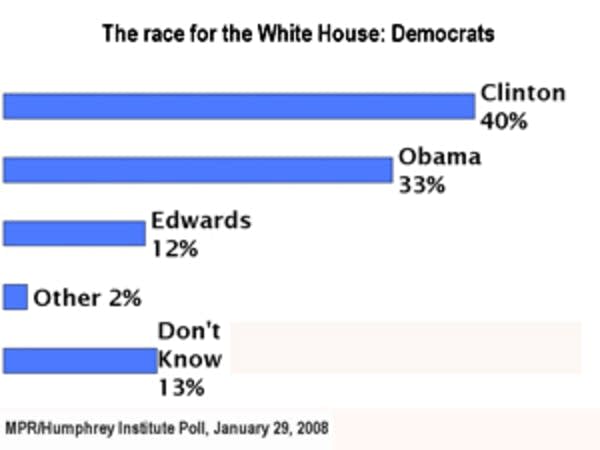Poll: Clinton, McCain leading in Minnesota

The poll of 917 Minnesotans last week found 317 respondents who identified themselves as Republicans. Forty-one percent of those Republicans favored John McCain for president. Mike Huckabee followed with 22 percent and Mitt Romney had 17 percent.
Larry Jacobs, who directs the Humphrey Institute's Center for the Study of Politics and Governance, said McCain has opened a commanding lead in the state.
"He's able to appeal to a lot of different segments of Minnesota Republicans," Jacobs said. "We're seeing men and women rallying to his side. We're seeing folks who think the country is going in the right direction and the wrong direction heading over his way. And they trust him on the economy and jobs. So the strategy that's working for Mitt Romney in other states is not working in Minnesota among Republicans."
[image]
Create a More Connected Minnesota
MPR News is your trusted resource for the news you need. With your support, MPR News brings accessible, courageous journalism and authentic conversation to everyone - free of paywalls and barriers. Your gift makes a difference.
Jacobs cautioned the poll is not a prediction of Tuesday night's precinct caucuses. The interviews did not identify likely caucus participants. Gary Puffett of Minnetonka said he doesn't plan to attend his caucus, but he supports John McCain.
"McCain has been more willing to reach across the aisle on many occasions," Puffett said. "And we need to have more cooperation between both sides of the House and Senate, and McCain is more able to do that than the others."

There were 478 poll respondents who identified themselves as Democrats. Forty percent support Hillary Clinton for president, followed by Barack Obama with 33 percent. John Edwards, who ended his campaign Wednesday, had 12 percent.
Larry Jacobs said gender and age are important ingredients in the Democratic contest.
"Hillary Clinton has got a tremendous advantage among women over Barack Obama," Jacobs said. "And then when we look at other key factors, such as age, we're seeing Barack Obama winning decisively among younger Minnesotans, while Hillary Clinton is doing better among Minnesotans and Democratic Minnesotans 45 and over."
Poll respondent and Clinton supporter Maggie Eriksson of Fergus Falls said she's ready for change in the White House, and gender is a key factor in her choice.
"Oh, it's very important," Eriksson said. "And if Obama wasn't running against her, it would also be extremely important to vote for a black. Anybody who breaks this tradition of the all WASP presidency would automatically get my vote."
The departure of John Edwards puts 12 percent of Minnesota Democrats up for grabs and could make the contest even tighter. Edwards' Minnesota supporters were already looking for a new candidate.
Barbara Schendel of New Brighton said she's disappointed that Edwards decided to drop out of the race. Schendel describes Barack Obama as her next best choice.
"He seems to have a message that's not quite as populist as Edwards, but not quite as corporate- friendly as Hillary," Schendel said. "He does actually fall somewhere in between. So, that to me is still better."
Election Day is still more than nine months away, and the presidential nominees are far from decided. But Larry Jacobs said the poll results on head-to-head match ups show Minnesota could heavily favor the Democratic candidate in November.
"Obama and Clinton have opened up sizeable double-digit leads over all the Republican candidates," Jacobs said. "Obama is ahead of McCain by 13 points. Clinton has got a 10-point advantage over McCain. And then when you turn to the Huckabee and Romney and Giuliani matchups, the leads are substantially larger."
The margin of error for the full sample of 917 Minnesotans is plus or minus 3.2 percentage points. The margin increases to 5.5 points for the sub-sample of Republicans and 4.5 points for the sub-sample of Democrats.
